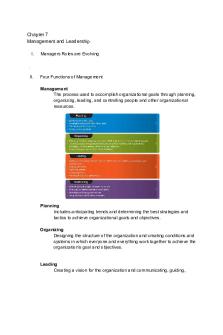Chapter 7 PDF

| Title | Chapter 7 |
|---|---|
| Author | Anonymous User |
| Course | Network Security |
| Institution | جامعة القاهرة |
| Pages | 6 |
| File Size | 544.1 KB |
| File Type | |
| Total Downloads | 17 |
| Total Views | 171 |
Summary
ch 7...
Description
Chapter 7 1-What is the position of the transmission media in the OSI or the Internet model?
Ans: The transmission media is located beneath the physical layer and controlled by the physical layer 2- Name the two major categories of transmission media The two major categories of transmission media are guided media and unguided media.
3-"How do guided media differ from unguided media? 4-What are the three major classes of guided media? The three major classes of guided media are twisted &pair cables' coaxial cables' and fiber optic cable
5-What is the significance of the twisting in twisted &pair cable? The main reason for twisting in a twisted pair cable is cancelling out any electromagnetic interference (EMI) that may be given out by external sources. These external sources could include crosstalk from other nearby pairs of cables or electromagnetic radiation given out by pairs of twisted cables that are not shielded ( UTP- unshielded twisted pair). This method was created by Alexander Graham Bell.
6- What is refraction ? What is reflection ? Reflection: This occurs when a wave travelling in one medium strikes the surface of a different medium and changes direction so that it returns back into the medium in which it was originally travelling in. Simply put the waves bounce back. Examples of reflection are light waves striking a mirror or echoes in which sound waves are reflected of a solid surface. Refraction: The speed at which a wave travels is dependent upon the medium in which it travels along or through. The speed of a wave changes when a wave moves from one medium to another. This change in wave speed is accompanied by a change in wavelength and change in direction. It is this change of direction or bending of the wave as it passes from one medium to another that is called refraction. Example, light travelling from air into water.
7-What is the purpose of cladding in an optical fiber? Optical fiber transmits optical signals using refraction of that signal. for refraction to happen the densities at the refracting media should be different. for this purpose a cladding is used. cladding is of higher density so that optical signal can undergo refraction and transmit the signal to long distances. 8-Name the advantages of optical fiber over twisted –pair and coaxial cable ? 1-noise resistance
2- less signal attenuation
3- higher bandwidth
9- How does sky propagation differ from line of sight propagation ? In sky propagation radio waves radiates upwards into the ionosphere and then reflected back to the earth .In the line of sight propagation signal are transmitted in a straight line from antenna to antenna 10-what is the difference between omnidirectional waves and unidirectional waves ? Omnidirectional waves are propagated in all direction while unidirectional propagated in one direction -
12- Use the result of exercise 11 to infer that bandwidth of a UTP cable decreases with an increase in distance ?
13- If the power at the beginning of a 1 Kln 18-gauge UTP is 200 mw, what is the power at the end for frequencies 1KHz , 10KHz , and 100 KHz ? use the result of exercise 11
15- Use the result of exercise 14 to infer that the bandwidth of a coaxial cable for the indicated frequencies and distance
For a specific maximum value of attenuation , the highest frequency decreases with distance , if we consider the bandwidth decrease with distance . for example if we can tolerate a maximum attenuation of 50db (loss), then we can give the following of distance verses bandwidth
16-If the power at the beginning of a 1Kln 2.6/9.5 mm coaxial cable is 200 mw , what is the power at the end for frequencies 1 KHz, 10KHz , and 100KHz? Use the result of exercise 14...
Similar Free PDFs

Chapter 7 quiz#7
- 3 Pages

Assignment #7 Chapter 7
- 2 Pages

Chapter-7
- 7 Pages

Chapter 7
- 4 Pages

Chapter 7
- 57 Pages

Chapter 7
- 46 Pages

Chapter 7
- 7 Pages

Chapter 7
- 1 Pages

Chapter 7
- 5 Pages

Chapter 7
- 8 Pages

Chapter 7
- 34 Pages

Chapter 7
- 10 Pages

Chapter 7
- 10 Pages

Chapter 7
- 32 Pages

Chapter 7
- 46 Pages

Chapter 7
- 10 Pages
Popular Institutions
- Tinajero National High School - Annex
- Politeknik Caltex Riau
- Yokohama City University
- SGT University
- University of Al-Qadisiyah
- Divine Word College of Vigan
- Techniek College Rotterdam
- Universidade de Santiago
- Universiti Teknologi MARA Cawangan Johor Kampus Pasir Gudang
- Poltekkes Kemenkes Yogyakarta
- Baguio City National High School
- Colegio san marcos
- preparatoria uno
- Centro de Bachillerato Tecnológico Industrial y de Servicios No. 107
- Dalian Maritime University
- Quang Trung Secondary School
- Colegio Tecnológico en Informática
- Corporación Regional de Educación Superior
- Grupo CEDVA
- Dar Al Uloom University
- Centro de Estudios Preuniversitarios de la Universidad Nacional de Ingeniería
- 上智大学
- Aakash International School, Nuna Majara
- San Felipe Neri Catholic School
- Kang Chiao International School - New Taipei City
- Misamis Occidental National High School
- Institución Educativa Escuela Normal Juan Ladrilleros
- Kolehiyo ng Pantukan
- Batanes State College
- Instituto Continental
- Sekolah Menengah Kejuruan Kesehatan Kaltara (Tarakan)
- Colegio de La Inmaculada Concepcion - Cebu